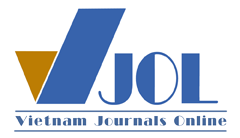Influence of some parameters on synthesis processes of triethyl ammonium oleate and triethyl ammonium stearate
DOI:
https://doi.org/10.62239/jca.2024.056Keywords:
ionic liquids, fatty acids, triethyl amine, oleic acid, stearic acidAbstract
Two ionic liquids named triethyl ammonium oleate ([TEA][Oleate] and triethyl ammonium stearate ([TEA][Stearate]) were synthesized from triethyl amine and oleic/stearic acids in water and in ethanol solvents. The synthesized ionic liquids were characterized by FT-IR and NMR spectra to confirm their structure. The influence of some parameters such as structure of ionic liquid anion, solvent, reaction time, reaction temperature, and acid/amine molar ratio on the synthesis processes of triethyl ammonium oleate and triethyl ammonium stearate was investigated. Ethanol was found suitable as a solvent for these processes because it dissolves formed ionic liquids but does not dissolve co-product KCl. In order to shift the equilibrium to increase the ionic liquid yields, an access amount of acids was used. Stearate-based ionic liquid should be synthesized at higher a temperature and longer time than oleic-based ionic liquids.
Downloads
References
S. Spange, C. Lienert, N. Friebe, and K. Schreiter, Phys. Chem. Chem. Phys. 22 (2020) 9954–9966. https://doi.org/10.1039/D0CP01480J
T.T.L. Bui, H.T.N. Uong, N.C Pham, Chem. Pap. 75 (2021) 1567–1579. https://doi.org/10.1007/s11696-020-01328-6
T. Welton, Rev. 10 (2018) 691–706. https://doi.org/10.1007/s12551-018-0419-2
P. Oulego, D. Blanco, D. Ramos, J.L. Viesca, M. Díaz, A. Hernández Battez,, Journal of Molecular Liquids 272 (2018) 937–947. https://doi.org/10.1016/j.molliq.2018.10.106
T.T.L. Bui, H.T.N. Uong, D.K. Nguyen, Korean J. Chem. Eng. 37 (2020) 2262–2272. https://doi.org/10.1007/s11814-020-0659-2
T. L. T. Bui, W. Korth, A. Jess, Opportunities and Challenges at the Interface between Petrochemistry and Refinery DGMK/SCI-Conference October 10-12, 2007, Hamburg, Germany, ISBN 978-3-936418-70-5
A. E. Somers, P. C. Howlett, D. R. MacFarlane and M. Forsyth, Lubricants 1 (2013) 3-21; https://doi.org/10.3390/lubricants1010003
R. Kreivaitis, A. Kupcinskas, A. Zunda, T. N. Ta, J. Haur H., Wear 492-493 (2022) 204217, https://doi.org/10.1016/j.wear.2021.204217.
P. Berton, S. Manouchehr, K. Wong, Z. Ahmadi, E. Abdelfatah, R. D. Rogers, and S. L. Bryant, ACS Sustainable Chem. Eng. 8 (2020) 632-641. https://doi.org/10.1021/acssuschemeng.9b06336
Y. Zhou, J. Qu, Appl. Mater. Interfaces 9 (2017) 3209–3222, https://doi.org/10.1021/acsami.6b12489
M. T. Donato, R. Colaço, L. C. Branco, B. Saramago, J. Mol. Liq. 333 (2021) 116004. ttps://doi.org/10.1016/j.molliq.2021.116004
T. Raj, K Chandrasekhar, J. Park, S. Varjani, P. Sharma, D. Kumar, J.J. Yoon, A. P, S.H. Kim, 307(Pt 2) (2017 135787. https://doi.org/10.1016/j.chemosphere.2022.135787
Z Li, T. Ren, Tribology International 109 (2017) 373–381. https://doi.org/10.1016/j.triboint.2016.11.032
M.M.S. Abdullah, N.A. Faqihi, Hamad A. Al-Lohedan, Z.M. A. Abdulnasser, M. Karami, Fluid Ph. Equilib. 568 (2023), 113737. https://doi.org/10.1016/j.fluid.2023.113737
B. Breuer, T. Stuhlfauth, H.P. Fock.. Journal of Chromatographic Science. 25 (1987): 302-306. https://doi.org/10.1093/chromsci/25.7.302
Y Atef and A. Ghanem, 2020 IOP Conf. Ser.: Mater. Sci. Eng. 975 012014
T. T. L. Bui, T. A. Dang, K. Borin, T. N. Ly, T. T. Pham, T. X. T. Phan, N. Pham-Cong, Vietnam Journal of Catalysis and Adsorption, 12(1) (2023) 74-80. https://doi.org/10.51316/jca.2023.012
Downloads
Published
Issue
Section
License
Copyright (c) 2024 Vietnam Journal of Catalysis and Adsorption

This work is licensed under a Creative Commons Attribution-NonCommercial 4.0 International License.











